The impolitic side of me...
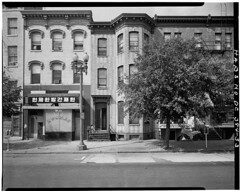
BUILDINGS AT 907-911 N.Y. AVE. HABS, 1979.
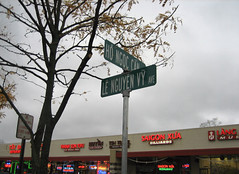
Flickr photo of Eden Center parking lot sign, Fairfax County (this is Vietnamese) by mj*laflaca.
sometimes says, let's recognize the urban sociological concept of "ecological succession" (also called invasion-succession theory) and move on...
From Dictionary of Sociology Date: 1998 Author: GORDON MARSHALL
Invasion–succession model: A theoretical construct, setting out the sequence of competitive social actions by which a human group or social activity comes to occupy and dominate a territory, formerly dominated by another group or activity. See also CONCENTRIC ZONE THEORY; ECOLOGY; HUMAN ECOLOGY; URBAN ECOLOGY.
Is it really possible to retain a community's ethnic heritage when for the most part people representing that heritage no longer live there? Or shouldn't we have been concerned about this when outmigration was happening, rather than long after it is too late?
I ask this about Chinatown in DC. See "The Shrinking of Chinatown," subtitled "Group Is Working on a Strategy to Restore Neighborhood's Asian Identity" from yesterday's Post, which discusses a community planning effort.
Contrast it to this article, "Chinatown’s staying power: A neighborhood grows without losing its immigrant population," about Chinatown in Chicago, from a 2006 issue of the Chicago Journal. Chicago has been able to maintain its Chinatown in the face of development pressures.
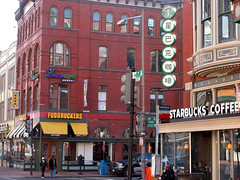
At Chinatown's "100 %" intersection of 7th and H Streets NE, none of the businesses on the four corners of the intersection are Asian. Few of the businesses on 7th Street, from G Street to Massachusetts Avenue are Asian. Only a handful of Asian businesses exist on H Street from 6th to 8th Streets. Photo by Kennedy Smith.
But when you lose your critical mass of residents, you have no advocates and institutions able to maintain a neighborhood's identity and authenticity. A bunch of Chinese restaurants (plus one senior home) and Chinese lettering on the signs of chain retail do not make a Chinatown.
In the DC region, Asian energy has moved to the suburbs, particularly in Annandale and Fairfax County. Partly this was due to the high cost of land in the center city as well as the continued reduction in size of "Chinatown" (which at one time was also a Greek neighborhood, if you can believe George Pelecanos, and before that it was German-American), especially the construction of the Old Convention Center, which destroyed four blocks of "Chinatown."
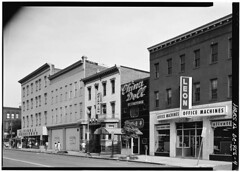
600 Block H Street, N.W. MAIN ELEVATIONS HABS DC,WASH, 548-4. 1980
But it was also due to outmigration. As people improve economically, they tend to move out of the center to "better" neighborhoods. This happened with DC's Asians, especially given the riots, and as critical mass was developed in Arlington County and Fairfax County, later immigrants moved there directly without stopping first to live in the center city. (A similar phenomenon has occurred with Langley Park and Latinos. Also see this piece from the Gazette, "Destroy the Langley Park neighborhood?" about the same process, and fears that the light rail will lead to the reproduction of Langley Park away from Latinos.)
This is an interesting question because of the success at the maintenance of Chinatowns in Manhattan and Flushing, Queens, to some extent Philadelphia, Los Angeles, and of course, San Francisco. In New York City, Little Italy is in fact endangered by the growth of a thriving Chinatown.
I think it is pretty clear that without residents, you can't have a "Chinatown." If you want a more authentic Asian ethnic experience in the DC region, I think it's pretty clear you have to go to Annandale.
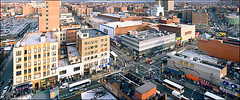
Chinatown, Flushing, Queens. Photo: Jeff Chien-Hsing Liao from "In the Shadow of the No. 7 Line" in the New York Times.
Labels: agglomeration economies, invasion-succession theory, retail, urban revitalization



0 Comments:
Post a Comment
<< Home